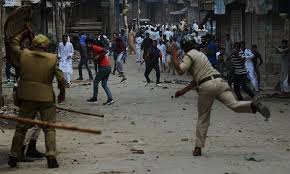Kashmir’s Future in the Shadow of Demographic Change

The region of Jammu and Kashmir, particularly in its Indian-occupied portion, has long been a flashpoint of political tension, territorial disputes, and human rights concerns. However, in recent years, the situation has worsened, with the Indian government under Prime Minister Narendra Modi making calculated moves to dismantle local authority, enforce demographic changes, and reshape the region to fit its strategic objectives. One of the most worrying aspects of these efforts has been the systematic encroachment on Kashmiri land, the forced evictions of locals, and the increasing settlement of non-locals—steps that many critics argue amount to an attempt to alter the region’s demographic makeup and fundamentally reshape its political landscape.
The Modi government’s actions are widely viewed as part of a larger strategy to impose a vision of demographic apartheid in Jammu and Kashmir. Since the abrogation of Article 370 in August 2019, which stripped the region of its semi-autonomous status, India has introduced a range of legal and administrative measures aimed at facilitating the settlement of non-locals. This process includes granting electoral rights to non-Muslims who were not originally residents of the region, and encouraging them to register as voters. The result has been the creation of a massive influx of new voters—around 2.5 million—some of whom are being added through controversial changes to the electoral rolls. These changes could lead to an approximate 30 percent increase in the voter base, tipping the balance in favor of the Hindu-majority settlers and potentially enabling the Bharatiya Janata Party (BJP) to further solidify its grip on power.
This shift in the political landscape has been accompanied by a systematic alteration of the region’s social and economic fabric. Over the last two years, the Indian Army has demolished over 50 Muslim-owned houses and displaced more than 200 families under the justification of strategic interests. These forced displacements, often executed under the guise of development or security, are part of a broader pattern of land appropriation and settlement aimed at reengineering the region’s demographic makeup. Under the Modi regime, the Indian government has been increasingly focused on enabling non-local Hindus to settle in Jammu and Kashmir, with reports revealing that nearly 9,000 individuals have been allotted 5 Marla plots each under the “land for landless” scheme. While this scheme may be presented as a form of welfare or economic development, critics argue that it serves a much darker purpose: to encourage the influx of non-Muslims into the region, shifting the balance of power in favor of the BJP.
Perhaps most troubling, however, is the growing militarization of Jammu and Kashmir. The Indian government has invoked sweeping powers under the Jammu and Kashmir Development Act, which allows the Indian Army to claim possession of any land it deems “strategic.” This law, combined with the active settlement of non-locals and the increasing encroachment of military forces, has led to a situation where even the basic rights of the local Kashmiri Muslim population are systematically undermined. In addition, the Indian military has already seized over 53,000 hectares of land in Kashmir, with further land grabs anticipated under various schemes, such as the allocation of 336 flats to non-Kashmiris and plans to build housing colonies for army personnel. This has led to the further marginalization of the local population and the consolidation of power in the hands of the Indian state and its military apparatus.
The underlying intention behind these efforts is clear: India is attempting to normalize its illegal occupation of Jammu and Kashmir and secure its hold on the region, at the expense of the Kashmiri people. The settlement of non-locals, the modification of the electoral system, and the erosion of local control over land and resources all serve to reinforce this strategy of settler colonialism. The government’s actions have been widely condemned by human rights organizations such as the UNHRC and Amnesty International, which have criticized India’s ongoing violations of international law and human rights standards in the region. Despite this, the Indian government has shown little regard for international pressure and continues to push forward with its agenda of demographic manipulation and political control.
This assault on the rights of the Kashmiri people is not just about land or resources; it is about erasing the distinct cultural and religious identity of the region. The Modi government’s actions in Jammu and Kashmir are a direct challenge to the region’s Muslim majority, and they are part of a larger effort to impose a Hindutva ideology on the area. By systematically undermining the rights of the Muslim population, the Indian state is attempting to erase Kashmir’s unique history and culture, replacing it with a narrative that fits the BJP’s vision of India as a Hindu-majority nation.
In this context, the actions of the Indian government are not just a matter of regional politics; they are part of a wider strategy of coercion and control that threatens the very fabric of Kashmiri society. From land grabs to the forced displacement of Muslim families, to the influx of non-local settlers and the erosion of democratic rights, the situation in Jammu and Kashmir is rapidly deteriorating. These moves have pushed the region further toward instability and conflict, with the BJP’s agenda of demographic engineering exacerbating tensions and fueling resentment among the local population.
It is clear that the situation in Jammu and Kashmir has become a political playground for the Indian government, which seeks to impose its will on a region that has long been resistant to external control. The international community must continue to monitor the situation closely and hold India accountable for its violations of human rights and international law. The future of Jammu and Kashmir hinges on the protection of the rights of its people and the preservation of its unique identity. Without a concerted effort to reverse these harmful policies, the region’s future remains uncertain and fraught with danger.











